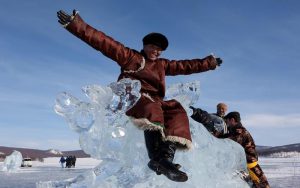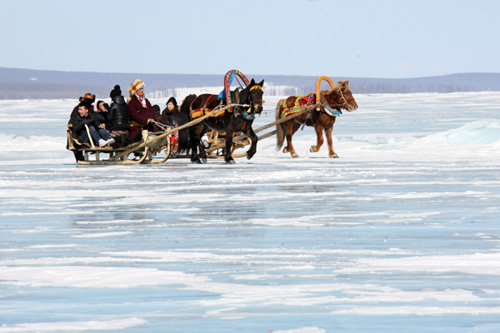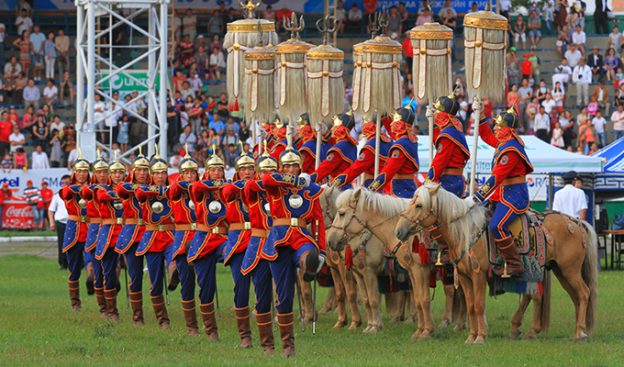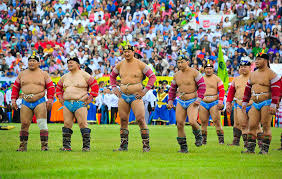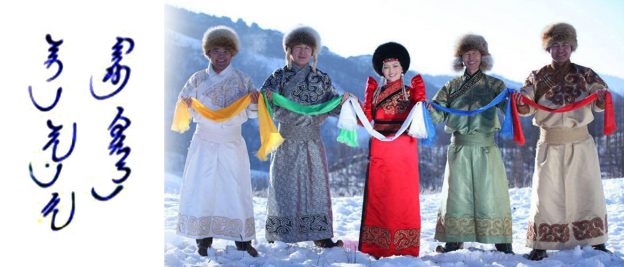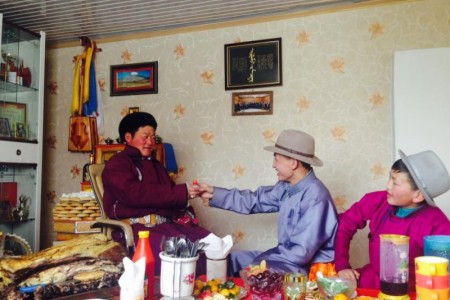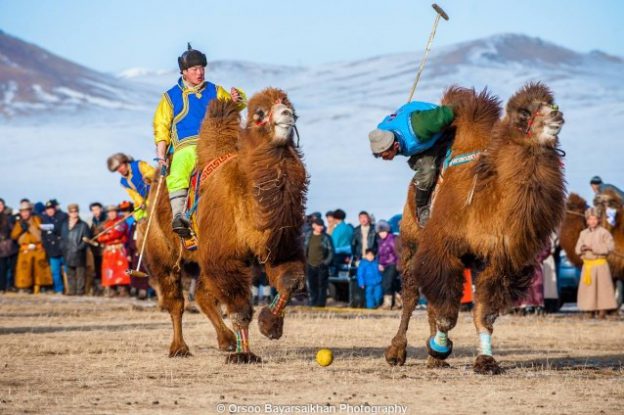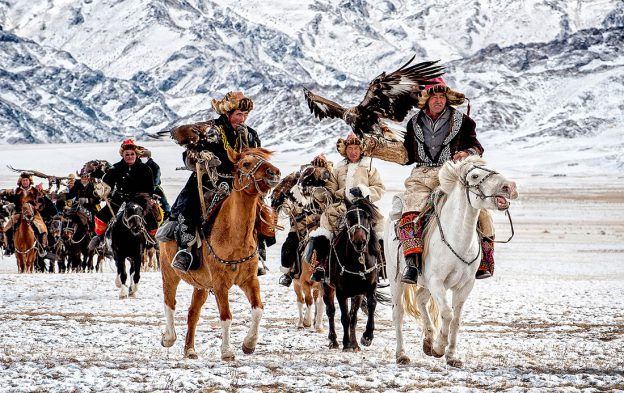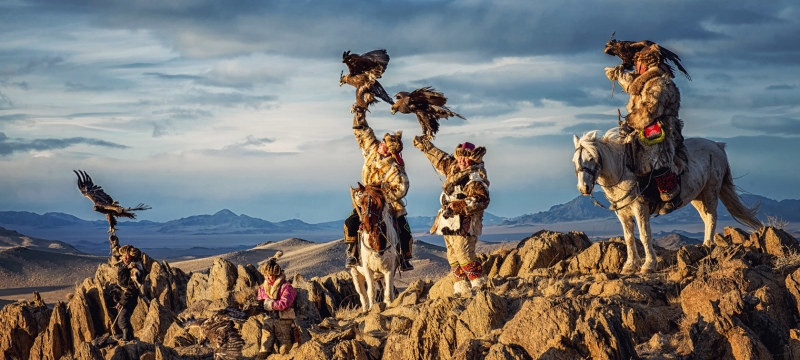
Kazakh eagle hunter in Altai Tavan Bogd National Park, Mongolia.
The Eagle festival, or Golden Eagle festival is an annual traditional festival held in Bayan-Ölgii aimag, Mongolia. In the eagle festival, Kazakh eagle hunters celebrate their heritage and compete to catch small animals such as foxes and hares with specially trained golden eagles, showing off the skills both of the birds and their trainers. Prizes are awarded for speed, agility and accuracy, as well as for the best traditional Kazakh dress, and more.
The Eagle Festival is held during the first weekend in October, run by the Mongolian Eagle Hunter’s Association. Dark, rocky mountainous terrain forms the backdrop to the festivities which incorporate an opening ceremony, parade, cultural exhibitions, demonstrations and handcrafts in the center of town of Ölgii followed by sporting activities and competitions 4 km out towards the mountains. Dressed in full eagle hunting regalia and mounted on groomed decorated horses, the entrants compete for the awards of Best Turned Out Eagle and Owner; Best Eagle at Hunting Prey and Best Eagle at Locating Its Owner from a Distance. Other sporting activities include horse racing, archery and the highly entertaining Bushkashi – goatskin tug of war on horseback.
A smaller festival, the Altai Kazakh Eagle Festival is also held each year in the nearby village of Sagsai in the last week of September. It follows much the same pattern as the larger Golden Eagle Festival, with about 40 eagle hunters participating.
Mongolians in Altai (Kazakhs) Eagle Hunting History (over 2000 years old)
Before put here many legends about Altai Kazakh Eagle hunting history, let me to give some information about Golden Eagle and Altai Kazakh Hunting Skills.
Golden Eagle is a bird of eagles family, predatory class, In Kazakhstan lives everywhere, except – wood less deserts and steppes; in the south of Kazakhstan – settled, in the North – partially migratory. Size – up to 95 sm, wing-span – up to 220 sm, weight 4 – 6 kg. Plumage is of the same kind, dark – brown, nape and neck – goldish-red, young individuals have white, with a wide black strip on the end, tail, lower part of a wing – with large white spots. A down nestling – only white. Gplden Eagle settles in couples, making huge (up to 2 мin a diameter) nests in niches and on ledges of rocky breakages, on trees. In March- April hen lays 1 – 3 eggs (hen sits on eggs about 45 days) . The nestlings leaves nests in 2,5 months of old, but parents are guardians along time. Golden Eagle lives about 100 years in natural conditions. Eats: in mountains – marmots, kekliks, ulars, reven and gophers; in deserts – sandpiper, rabbits, partridges, hazel grouses, turtles, snakes and etc. Occasionally attacks the foxes and badgers.
The Kazakh names of Golden Eagle. Long since Golden Eagle is used as hunting bird. The hunting with Golden Eagle is specific , at the present time, is supported by the experts – hunters (berkutchi). A hunting with Golden eagle requires special knowledge and patience. The hunters – berkutchi names Golden Eagle depending on age: till 1 year – balapan, 2-year’s – kantubit, 3-year’s – tyrnekl, 4-year’s – tastulek, 5-year’s – muzbalak, 6-year’s – koktubit, 7-year’s – kana, 8-year’s – zhana, 9-year’s – maytubit, 10-year’s – barkyn, 11-year’s – barshyn, 12-year’s – shogel. Golden Eagle is a very rare bird and booked in the Red book of Kazakhstan and USSR.
Hunting with Golden Eagle is one of the most unique features of the Kazakh life. The hunter is named kusbegi or berkutchi. The experience of wild birds training was gained by Kazakh kusbegi by centuries, the secrets were impacted from the father to the son and kept deep secret. At the present time we can meet few people with such name. These masters have innate gift of wild birds training. For a hunting they tame falcons, golden eagles and eagles. Names of birds are given depending on their appearance and battle characteristics. The hunting with Golden Eagle are during ten centuries. Was considered, to present the teenager a nestling of hunting bird, means, to wish to him to begin courageous, strong dzhigit. To train golden eagle – it is the high art. The caught bird gradually accustom to the owner. For it berkutchi some nights doesn’t close eyes and interdicts to sleep golden eagle. The bird can take feed (bits of uncooked meat) only from hands of the owner. After bird will get used to the hunter- berkutchi, his horse and dog, berkutchi begins to train to hunt for stuffed fox and only then the real hunting begins. Specially trained golden eagle hunts for small animals: rabbits, foxes, partridge, black hazel grouses.
Equipment for a hunting with hunting birds. For a hunting with hunting birds specially prepare equipment: a coverlet, cap, couch and leash. Bardak – special wooden prop for a hand – try without it to bring on the stretched out hand a bird of weight 6-7 kg! Shyrga – skin of hare or fox is filled with straw. This is manual for a bird. The hunter drags along shyrga with long rope along steppe and teachs golden eagle to attack prey. Kusbegi must have inexhaustible patience and persistence.
There are many legends about Altai Kazakh Eagle hunting.As far,we keep in touch with Altai Kazakh Eagle hunters every day and live together, decided to publish a legends,articles and Eagle hunter’s talking.
1.Eagle hunter-Kuanbay,
I think Kazakh Eagle hunting has over 2000 years history.When i was child (around 1950 yrs) famous local Eagle hunters Sepdolda and Juldyzbai took me as scare-boy for fox and rabbit.During hunting they made really often breaks and Eagle hunters talked to each other about Eagle hunting history.
Sepdolda said:
-Old time Kazakhs called eagle as Shegirbayan.One Kazakh eagle hunter after long day hunting came to Kazakh nomadic family to spend overnight.As Kazakhs are grade hospitality people,host killed one of his 6-7 goats to feed his guest.This family didn’t have child.When host saw how eagle is cold,hungry and tired asked his wife to make fire for all night,so eagle can stay warm.Gave to eagle some meat.Next morning hunter left a family with his magnificent bird after good rest and said many thank to host,because they fed-up his bird also. Eagle was ready for next hunting.
After this visit, wife gave a birth to boy.And host thought,that god gave this boy,because his family fed up the eagle.from this moment,Altai Kazakhs call the eagle like “Birkut”,which means fed-up in English.
